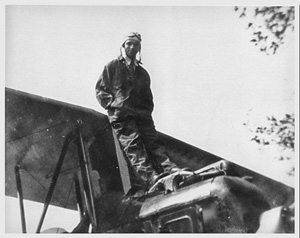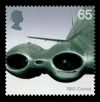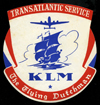Aviation at Mid-Century
Following my dad’s example, I learned early to keep my eyes on the sky and my ears open to the sound of approaching aircraft.

While he was dating my mother in his late teens, my dad was a barnstormer’s assistant. After losing two friends, one who died following the crash of his plane in the Allegheny Mountains, and the other who fell to his death when his parachute failed to open after jumping from his plane, he decided that aviation and romance were mutually exclusive pursuits. However, he never lost his fascination for aircraft of any sort, and fostered that interest in me.
As far back as I can remember, I’ve rarely heard an airplane without looking skyward to try to see it and identify it. And I’ve learned that, for me at least, some airplanes — propliners all — are far more interesting than any jet ever flown.
Propliners? What’s a propliner?! The word is a portmanteau bringing together the words propeller and airliner. Although the theory behind the modern jet turbine engine dates back to the aeolipile, a device described by Hero of Alexandria in 1st-century Roman Egypt, it took nearly 2,000 years for technology to catch up to theory. In 1939, just five days before the Second World War started in Europe, the world's first aircraft to fly under turbojet power, the German Heinkel He 178, took to the skies. Less than a decade later, on July 27, 1949, the world’s first jetliner, the de Havilland Comet, took off, metaphorically, in the Heinkel’s slipstream. But the Comet, as impressive as it was despite design flaws that resulted in tragic crashes, was little more than a propliner whose engines had been swapped out for turbojet engines.
The first modern propliners — bigger, faster, roomier, quieter, sleeker, and higher flying than the wood-and-cloth “stringbags” that preceded them — first took to the air in the early 1930s. For the first time ever, airline passengers willing and able to pay for the privilege could cross continents and oceans in hours, eclipsing the days or even weeks that trains and ships required for the same journeys.
I was fortunate enough to have been born in 1943, a decade into the two-decade heyday of propliners. My first airliner flight, in a Western Airlines Electra II propjet (a propliner powered by jet turbine engines, transported me in style from Albuquerque, New Mexico to San Diego, where I would begin basic training in the U.S. Navy. On subsequent leaves during my four-year tour of duty, I flew in several different propliners — Douglas DC-3s, Fairchild F-27s (a twin-engine turboprop), other Electra II’s, and in the most memorable flight of all, a Lockheed Constellation from Travis Air Force Base near San Francisco to Tachikawa AFB near Tokyo.
Inevitably, jets began to replace propliners on all but regional routes. My new wife and I flew from our hometown, Silver City, New Mexico to Tucson in a Convair 580 turboprop airliner. A couple of years later, we flew in an Ozark Airlines DC-3 from Columbia, Missouri to Kansas City, where we boarded a jetliner heading for visits to our families in New Mexico. My last flight in a propliner, in the mid-1990s, was in the cockpit of a Northern Thunderbird Airlines Beech 18, a “baby DC-3,” from Prince George, British Columbia to the northern BC native reserve at Fort Ware.
Airplanes have been central to some of my best memories — and some of my worst; the web pages included in Aviation at Mid-Century reflect the "aviation sector" of my life.

The MiG-15 fighter re-defined aerial combat: A domestic post-Korean War cover pictures an iconic jet fighter of that conflict, the MiG-15. The transonic MiG-15, built in Russia and using a British engine design, challenged American aerial supremacy early in the Cold War (and lost).

I survived a plane crash in the Black Range: When I was 19, I limped away from a plane crash in a wilderness canyon in New Mexico’s Black Range. I was bruised, abraded, lacerated, and concussed. Every muscle in my body seemed to have been stretched or torn. You won’t believe I survived. I don’t believe I survived!

Christmas tragedy at Prestwick: The crash landing of a BOAC Stratocruiser airliner at Prestwick, Scotland, early on Christmas morning in 1954, wreaked havoc on families and destroyed the pilot’s distinguished career. A shipment of diamonds went missing, too.

North Star Falling: Death rained from the sky over Moose Jaw, Saskatchewan in 1954 when a Trans-Canada Airlines North Star airliner collided with an RCAF Harvard trainer. It was Canada’s worst air disaster up to that time.

A Comet Falls: In 1950s, airliners fell to earth every five or six days. On April 8, 1954 two of them fell to earth. One of them brought into serious question the safety of the world’s first successful jet liner, the British Comet, and ended Britain’s hopes of dominating the worldwide commercial aviation market.

Consternation in a Constellation: In 1948, when Ben Guilliamse was 14 years old, his family flew from their home in Curaçao to Amsterdam in a KLM Lockheed Constellation airliner. Over the North Atlantic at night, they faced possible disaster.

Low & Slow in a “Connie” — Flying to Japan in 1963: My first duty station after training to be a U.S. Navy hospital corpsman was at the U.S. Naval Hospital in Yokosuka, Japan, near Tokyo. It took a 26-hour flight in a Lockheed Constellation to fly to Tokyo via Hawaii and Wake Island from Travis Air Force Base, near San Francisco.met

A Charles Lindbergh Puzzle: A 1930 Spanish airmail stamp includes four design elements — a portrait of Lindbergh, his airplane (the Spirit of St. Louis), the Statue of Liberty, and … a cat! A cat? Why a cat? What the…? Well, it seems there was this kitten….